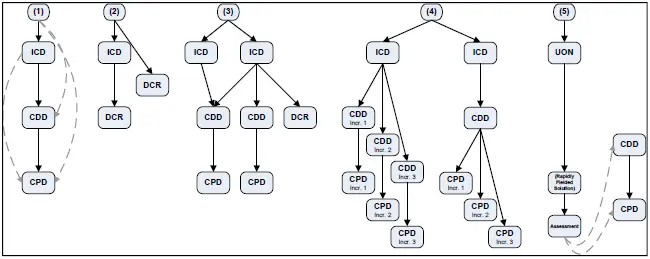
Figure: JCIDS Requirements Sequencing
1. The Initial Capabilities Document (ICD) is the most common starting point for new capability requirements. [1]
- Once validated, the ICD typically leads to an Analysis of Alternatives (AoA) and then the Capability Development Document (CDD) and Capability Production Document (CPD) for the development of a materiel capability solution.
- An ICD may lead directly to a CPD if capability requirements and associated capability gaps can be satisfied through Commercial Off-the-Shelf (COTS), Government Off-the-Shelf (GOTS), or Non-Developmental Items (NDI), with no significant development or integration efforts.
- In certain cases, a CDD or CPD may be generated without an associated ICD. This is typically done when there has already been a successful Joint Capability Technology Demonstration (JCTD) of the capability solution in an operational environment for a Joint Urgent Operational Need (JUON).
2. Joint DOTMLPF Change Recommendation (DCR) may be generated from an ICD in two different ways: [1]
- A Joint DCR may be generated from a validated ICD as a nonmaterial solution to a previously validated capability requirement and associated capability gap or as a complement to a materiel capability solution which will be developed through the acquisition process.
- A Joint DCR may be generated without an associated ICD if non-materiel approaches appear to be the most viable solution for identified capability requirements. See ICD or CDD Waiver Request
3. Combining and splitting document sequences [1]
- One ICD may lead to the creation of multiple CDDs and/or Joint DCRs. Each document contributes to satisfying only portions of the capability requirements identified in the ICD.
- Two or more ICDs may lead to the creation of a single CDD where the capability solution to be developed satisfies more than one capability requirement.
4. Related document increments [1]
- An ICD may lead to the creation of multiple CDDs for a System of Systems (SoS) or Family of Systems (FoS) approach.
- A single CDD may address a SoS, where a set of systems are integrated to deliver a unique capability solution.
- Separate CDDs are required for each system in a FoS where similar capabilities are provided through different approaches to achieve similar or complementary effects.
- A CDD may lead to the creation of one or more CPDs which is typical for incremental development efforts.
5. Urgent/Emergent Documents [1]
- CDDs and CPDs are not required for solutions to Urgent Operational Needs (UON)
- Following the fielding of solutions to UONs, the requirement Sponsor completes an assessment of operational utility to provide essential feedback for continuing rapid acquisition efforts and/or to identify the need for long term sustainment.
- For capability solutions transitioning to the deliberate acquisition process, the UON serves as part of the source material for the Sponsor to generate the CDD or CPD
AcqLinks and Resources:
- CJCS Instruction 3170.01 “Joint Capabilities Integration and Development System”
- JCIDS Manual of Operations
- Tutorial: JCIDS Process
Updated: 7/12/2017
